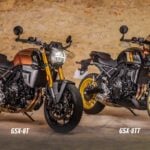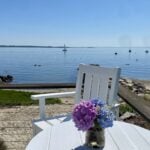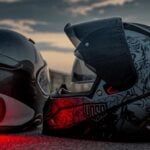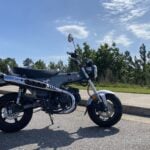“I always wanted to be fast enough.” -Sam Verderico, MotoAmerica Superbike Racer
Watching “On Any Sunday” is a ritual for me. When it’s too rainy or miserable to ride, I grab questionable leftovers from the back of the fridge, watch Bruce Brown’s 1971 masterpiece and bask in the young, innocent days of dirt track racing, desert scrambles and the Widowmaker Hillclimb.
I find solace in the grainy slow-motion footage of farmers racing the Elsinore Grand Prix in their overalls, in Malcom Smith’s beaming smile and Steve McQueen not being an actor at all, just being Steve McQueen.
Then there is Mert Lawwill. Mert, an icon of determination, loads his dirt tracker into his white van, drives himself to the racetrack, dominates races (or suffers mechanical breakdowns), loads his bike back into his white van, then drives back home. When he is not racing, he is in the garage late into the night turning wrenches on his bike to get faster.
As I watch I think, “This was 1970 and there is no way that this would be possible in today’s technological, high-budget world. A humble David from a small town could never compete with racing Goliaths by turning wrenches on his own bike, loading it into his white van, driving to a national level race and just riding fast. Maybe in 1971, but definitely not in 2020.”

He is David. They are Goliaths. A motorcycle is his sling.
I was wrong. His name is Sam Verderico, and he lives a few miles from my house.
I rode The Unicorn to Sam’s house and as I arrived, I saw the white van. The parallels between Mert and Sam began.
“Give me a second, I’ve got to get the paint out of the van.” I heard Sam, but all I saw were flip-flops with feet attached sticking out from the driver’s side door of a white van. Did I go back in time? Is this 1971?
Sam Verderico is a painter in my hometown of Wenatchee, Washington, a God-kissed land in the upper left of the United States snuggled into a valley between the Cascade Mountain Range and rolling wheat fields. The mighty Columbia River runs through the middle. Sam grew up here, but as pristine as this northwest haven is, his beginnings were anything but idyllic.
“When I was a kid, we were super poor, sometimes homeless. My dad watched AMA road racing on TV. It was his passion. We just watched Mike Tyson and motorcycle racing. That’s where I got my passion. My dad would say ‘Gosh, those guys are awesome’, and as I grew up thought, ‘You know, these guys are awesome. I want to do this.’”
So began a journey into motorcycle racing from someone who had never ridden a motorcycle. That’s right, never ridden a motorcycle.
“I never even rode a bike until I was 23,” Sam confided. “I bought a Kawasaki ZX-7 and went right to the racetrack. I didn’t know anything. I didn’t know how to counter steer, didn’t know how to brake. Keith Code was doing a school in Seattle so I just took the class, bought a leather suit and went up there to learn how to ride a bike.”
Ponder this: Mikey Lou Sanchez, the 10 year old double champion in the 110cc and 160cc Mini-Cup class, already has more racing experience than when Sam Verderico threw a leg over a ZX-7 at age 23.
“I didn’t have the parents that had dirt bikes like the guys I race against, like Cameron Beaubier and Toni Elias and all those people that have been bred to be the champions they are now.” Sam said. “I had to watch them on television: Miguel DuHamel, Doug Chandler, all those guys.”
Sam’s determination to be one of “those guys” was never in doubt.
“I met a guy who told me to race WMRRA (Washington Motorcycle Road Racing Association). So the next year I got my license and pulled in on a jet-ski trailer. My bike was bone stock. It still had a back seat. I just applied yellow tape. It still had the kickstand and everything. I just went out and raced.”

Kickstand and back seat gone now, Sam was readying this Yamaha R1 to accept new electronics when I interviewed him. “I’ve essentially been on the stock electronics on my R1s, just using a kit ECU to manage it,” he stated. “I came from no electronics when I started racing, so any electronics is awesome.”
I asked Sam how he did.
“It totally sucked. Everyone hated me. But then, as I slowly progressed, I got faster and faster and started winning championships. I said, ‘Screw it, I‘m going to Nationals. I’m fast enough.’ I’ve always wanted to be fast enough.”
And he was. Sam spent 8 years winning races in Washington State before extending to Oregon and California where Mike Sullivan showed him how to travel and started introducing him to people and most importantly, sponsors.
“He told me, ‘Go out and win a number one plate before you do Nationals. If you get a number one plate, you’re fast enough.’ It took me five more years but I finally got one.”
So Sam Verderico, who at 23 simply bought a bike and headed immediately to the racetrack, was off to Nationals.
The parallels between Sam Verderico and Mert Lawwill come in waves: both were born in the northwest, grassroots racers who worked their way through the ranks becoming national level racers, both have steel determination and I discovered both are skilled mechanics.
According to the movie, Mert spent 1,000 hours during that 1970 racing season wrenching on his bikes and his engineering work continued later in his life on mountain bikes and prosthetic hands. As I talked to Sam in his garage, most of our conversation happened over a Yamaha R1 Sam had torn down to accept new electronics before the race in Shelton. However his best wrenching happens not on motorcycles, but his collection of deadly fast boats.
“I don’t know how I got into boats. I bought this one (a 1991 Warlock offshore racing boat, the only one of its kind left in existence) and I loved it and started boating and just kept buying them. I like old things, things I can work on. I rebuild my own motors. I pull them out and work on them and build them and beef them up. I just like working on things.”
This made things interesting when he joined FLY Racing.
“That’s why Nationals was weird to me. They don’t let me work on things. They bring a crew in and I have to let the crew do it. It took me a while to trust my bikes. When I touch them (the bikes), I trust it. When I don’t ever see it and they are like ‘Get on it,’ I’m like, ‘Dude, did you guys tighten it all??’”

“Did you guys tighten everything??”
However, that was the least of Sam’s worries when he entered the Nationals level.
“Right when you start riding Nationals, the first thing you realize is that you don’t have any talent. You see them (the top racers) and you see what true talent is. The way they just slide into corners. I can’t even fathom the thought of how they just did that at 190 mph. You know, slid the front, saved it with the rear. I can’t do that. When you see that you’re like, ‘I’ll never be able to do that.’ But, I’ll go as fast as I can go.’ ”
Which is exactly what Sam did, against some of the best racers in the world.
“The first time I raced Superbikes was awesome. I was racing Josh Hayes and the Haydens. I showed up and was like, ‘Oh my gosh, I am in way over my head.’ Then I went out on the track with them at Texas and was trying to learn the track and they were pissed off at me and came and were like, ‘What are you thinking?’ And I was like, ‘I got it, I got it…’ I finally got un-knuckleheaded enough that they stopped bitchin’ at me. Here I am Washington State Champion and just a rookie and went, ‘Wow, it’s a big leap. A huge leap.’ But it’s the leap I always wanted. And I feel like I belong with them. So I keep doing this year after year. I just love it. Like I said, my dad burned it into me as a kid, just watching racers.”
Now, in a beautiful twist of irony, everyone watches Sam Verderico. However, some voice their opinion at his results.
“Anybody that batters or beats on me and says ‘Why did you get 12th out of 15 guys?’ I’m like, ‘I got 12th! You guys go do that!’ ”

Sam never takes making the MotoAmerica Superbike grid for granted. “That’s what’s cool about Nationals,” he said. “I get to race against people I look up to. Like Toni Elias has beaten Valentino Rossi, and Cameron Beaubier is just a beast. And I’m on the same track with these guys.”
“I always tell this to people: Just making the grid is insane because Cameron Beaubier is out there breaking track records. Then you’re thinking ‘Awww sheesh, I got to do 108% of his time which is only like 4 or 5 seconds off.’ So I’ve got to get out there really focused, get stretched, get warmed up and go as fast as I can and when the qualifying session is over I’m like, ‘I’m on the grid!’ There are guys that come out and don’t make the grid. They can’t make that time. Not even close. Every round somebody comes out, some local hotshot champion of the state comes out, fails and goes home. A lot of people see that and don’t ride Superbike. It’s just fearsome. If you don’t make the cut, you don’t race.”
So Sam keeps racing, doing what only about 15 people in North America have the skill and nerve to do.
At Shelton, Sam discussed the secrets of his hometown track with Max Flinders.“It’s usually me, Max and Jeremy Coffey competing,” he said.“Max Flinders, he’s just a grass roots racer, no money, just kinda bouncing along, and he makes all the rounds with his dad turning wrenches.”
“People ask me what Nationals is like and I say it’s like a normal guy can go play the Seattle Seahawks because I have natural ability and I’m fast and I get to go play in the NFL. All of those people (Cameron, Toni) are pro athletes. They are big-money, big-dollar, evil-fast, naturally talented people. You can’t go play the Seattle Seahawks but I can go race MotoAmerica against the best in the world. Just because I’m fast. I’m still learning though.”
And the earlier mentioned parallels between Mert Lawwill of 1970 and Sam Verderico in 2020, there is one that can’t be missed: the white van. That simple tool of the grassroots racer symbolizes resiliency, independence and determination, the hallmark of “a man, a van and a plan.” However, Sam’s pits are run out of FLY Racing’s gleaming race trailer, now making the white van almost obsolete.
Almost.
“I’m a paint contractor. That’s why I like my little paint van. I’ll throw a motorcycle in there and go to a race, pull my bike out, kick everybody’s ass, throw my bike back in and go home.”
Hearing Sam’s tone of voice I think that if Mert Lawwill was racing today, this is who he would be.
“Me? I don’t need anybody’s help,” Sam declares. “I’ve done all this myself. That’s how I’ve always done it. I do this for fun. If I’m not having fun, I’m done. I’m outta there.”

Sam was too sunburned from relaxing on his boat to wear a shirt for an interview. Such is our Northwest paradise. “This place (Wenatchee, Washington) is awesome. I love it here. I don’t want to leave. I come home from Nationals and we are all fizzled out after being on the road for six days. We fly home and once we land, the air is just like ‘ahhh…’ I literally sat in the boat all day, that’s why I’m burnt. Just floating down the river here is like paradise. It’s like a vacation every day to us.”
*photos & footage by Ted Edwards and Mark R. Wheeler





























Cool article. Keep living the dream my Brother.
Thank you for your comments Mike, humbling praise coming from a legend like you. The impact you have had on racing here in the Pacific Northwest will stand the test of time.
Great write up Ted!!
It was an honor to be able tell your story. Go add another chapter.
Go get’em SAM!
Great read 🙂
Thank you. Sam is humble and I thought his story needed to be told.
Great piece on Sam. I too hail from wenatchee.
There must be something in the water up here.
Keep having fun Sam. It’s been a lot of fun to watch your racing resume progress. Nicely written article as well!
Feel free to come whip up on the WMRRA boys/girls again soon.
I wonder if powerboat racing is next on Sam’s racing resume?
Great to see one of our guys on the national circuit!!!
The talent pool in the upper left is deep indeed.
Great article and interview, Ted. I’ve always tried to find Sam in the pits when I get to the races. Offer a smidgen of home town moral support. Top ten in that group is amazingly fast.
I watched Mert win at Castle Rock in the ’60s and stood there watching Gary Nixon work next to his white van. Decades later Nixon sat right behind me at Leguna.
On Any Sunday II is the Rodney Dangerfield of motorcycle movies but I like it because it has Bob Hanna, King Kenny and Bernie Schreiber. Bernie once accidentally wiped his nose on my arm when I was taking one of his classes. This is as close to greatness I’ll ever get. 🙂
Sam gets very close. Go Sam.
I spoke to Sam recently. He took a break from the pressure of MotoAmerica in 2021 but I hope to see him rejoin the grid in 2022. His story from being basically homeless to MotoAmerica Superbike racer is one of classic American grit.